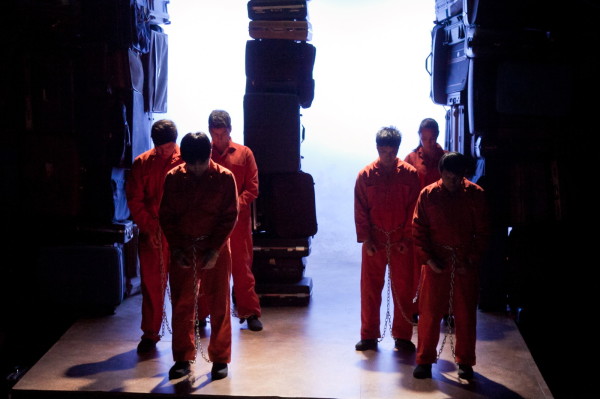Dwight Conquergood was a pathbreaking performance studies scholar and activist who became a dear friend to Albany Park Theater Project and many ensemble members. On the 10th anniversary of Professor Conquergood’s death, David Feiner, APTP’s producing artistic director, had the privilege to speak at “Cultural Struggles: A Symposium Honoring the Scholarship and Activism of Dwight Conquergood.” The Symposium took place at Northwestern University, where Professor Conquergood was on faculty for much of his career. David’s presentation shares some of the profound impact that Dwight had on APTP – and also details the making of APTP’s acclaimed production, Home/Land.
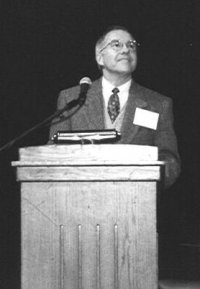
Professor Dwight Conquergood
I want to begin with a story, about my first encounter with Dwight. Unlike many of you, I did not first meet Dwight Conquergood in a classroom or through his published work. My relationship with Dwight began in the field, and, in a sense, I was his subject.
In 1999, Dwight came to see a performance by Albany Park Theater Project, the youth theater ensemble that I co-founded in 1997 with my late wife, Laura Wiley, who, like Dwight, died from cancer far too young. This was a homecoming of sorts for Dwight, as he had moved out of the Big Red apartment building and the Albany Park neighborhood just a few years earlier. The performance was called Beneath the Surface, and, like all of Albany Park Theater Project’s work, it was devised by teens based on real-life stories they gathered from members of their community. A collection of short plays, Beneath the Surface began with a piece from the perspective of a teen girl whose first crush dies in a gang shooting. That opening piece was followed by the story of a girl coming out as a lesbian at the neighborhood high school, at a time when that declaration of identity was even more dangerous than it remains today. Next came a piece inspired by interviews a girl in our company did with her parents, about her father divorcing her mother, entering a green card marriage, divorcing again, bringing the whole family to Chicago, and finally remarrying the girl’s mother. We set our performance of that story at the Chicago wedding that reunites the family, with the father and mother and children and even the green card wife celebrating the renewed nuptials with a multi-vocal storytelling of the journey that led them to that day. For intermission, we invited the audience onto the stage and served Mexican wedding cookies.
"Dwight narrated our work back to us, always revealing more complexity than we knew it contained, thereby encouraging us to new levels of complexity and awareness with APTP’s each successive project."
APTP Producing Artistic Director

David Feiner gives a talk in honor of Professor Dwight Conquergood.
At intermission, Dwight comes up to me, introduces himself and, with his characteristic combination of irrepressible enthusiasm and overcautious politeness, tells me he’s bowled over by the performance, that it tells the stories overlooked by the media – especially the stories of sisters and girlfriends and mothers and abuelas, that these high school students are doing performance ethnography at a graduate school level, and would Laura and I be so generous as to let him take us for a meal so he can ask if we’d be so generous as to allow him to observe and write about the company for a journal article.
From 1999 to 2004, Dwight spent countless hours at APTP. At first he observed workshops and rehearsals; soon enough, he began leading the occasional workshop for APTP teens, first in ethnographic methods and later to share his work on gangs and the death penalty, always beginning and ending by assuring the teens that really they were the ones teaching him. He took Laura and me to countless meals (for which he inevitably paid). Opening his field notes but really working from memory, he narrated our work back to us, always revealing more complexity than we knew it contained, thereby encouraging us to new levels of complexity and awareness with APTP’s each successive project. He built personal relationships with two generations of APTP teen ensemble members, bringing them to perform and lead workshops at Northwestern University, helping them with college applications, writing them recommendations, inspiring many to major in anthropology or sociology, guiding them in their course selection, and serving as a sounding board for their independent study proposals.
* * *
The journal article never happened. But I do not regret the time Dwight spent with us rather than writing about us, because the work APTP has done in the ten years since his death is as vital and vibrant a part of his legacy as an article would have been. I wish Dwight could have witnessed the ever-increasing scope of APTP’s ethnographic projects over the ten years since his passing. Today, I’m going to boast to you – and to Dwight – about one of which I am especially proud.
In December of 2010, a quarter of our youth ensemble members were themselves undocumented, and another half had undocumented parents, siblings, aunts, uncles.
We started work on the project that became Home/Land at the very end of 2010. We had recently closed our theater’s biggest “hit” at the time, a play called Feast that garnered us unprecedented attention from foundations, media, and elected officials, as well as a greatly expanded audience. As we began to consider our next project – and when I say “we” I mean the youth and the adults of Albany Park Theater Project collectively – we acknowledged that a lot of folks would be paying attention to what we did next. We resolved to devote our 15 minutes of fame to one of the most important issues for APTP teens and their families: the human impact of this country’s inhuman immigration policy.

Rossana Rodriguez, APTP's resident director, and Osbaldo Antunez, APTP ensemble member, at the second Coming out of the Shadows Rally.
In December of 2010, a quarter of our youth ensemble members were themselves undocumented, and another half had undocumented parents, siblings, aunts, uncles. We launched our project gathered in a circle in our home space in Albany Park, with those who were undocumented or lived in a household with undocumented family members describing the day-to-day experience of that existence. We heard a lot about living in fear, about being held back, about holding oneself back. We resolved that our play would unflinchingly depict the emotional and physical brutality of this country’s immigration system – but also that our play would not stop at telling the stories of victims. We would seek out and tell the stories of heroes.
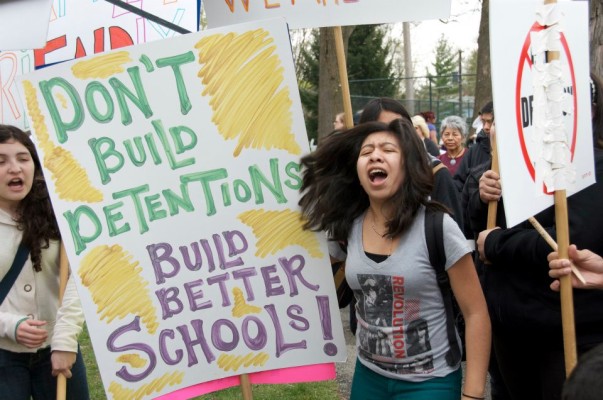
After our sharing circles at home, we began attending rallies, protests, and discussions throughout the city. Typically we would go in small teams: four, five, six youth and one or two adults. The youth would introduce themselves to speakers whose stories moved them, tell them about our project, seek invitations to upcoming events and planning meetings. Soon we were full-fledged participant-observers. The most natural entry point was the undocumented Dreamer movement, led by young adults just a few years senior to our ensemble members. APTP teens attended planning meetings for Chicago’s second “Coming Out of the Shadows” rally, and two of our youth ensemble members chose to speak at the rally on Daley Plaza where they themselves publicly came out as undocumented. By this time, thirty five of us had been working on the project for three months, learning and building relationships.
Our first interviews were with five of the original leaders in Chicago’s Dreamer movement: two women and three men; three Mexican, one Filipina, and one Palestinian; three studying in college, one a college graduate and one who left high school before graduating; two with work permits and two working under-the-table jobs; two still active leaders at the time in the Immigrant Youth Justice League, two having left to begin or engage with more radical immigrant rights groups, and one somewhere in the middle. That diversity was part luck but part design: our APTP youth perceived plurality and even dissent in the voices of the immigrant rights movement, they recognized that diversity as significant, and they were enamored of that diversity.

Jalen D. Rios plays the character inspired by Padre Jose Landaverde in Home/Land.
A teen ended every interview with the question, “Who else should we be talking to?” That led us to Little Village, to La Mision Señora de Guadelupe, where we interviewed the church’s founder and pastor, Padre Jose Landaverde. That was – to use a very scientific term from performance studies – the mother lode. Over the course of three, multi-hour interviews, Padre Landaverde told us much of his life story, from being orphaned at age nine when government soldiers in El Salvador massacred most of the adults in his village, to being taken in by and raised collectively in FMLN outposts in the mountains, to becoming part of the guerilla special forces at age 12, being taken prisoner, tortured and left for dead at age 16, being found and taken in by nuns and missionaries, brought to the United States, becoming a priest and an activist, and eventually turning an old bar into a mission where immigrants care for and fight for one another with a doctrine that is equal parts Paolo Freire and Jesus Christ.
Padre Landaverde was the mother lode not only because his story itself was so rich, but because our relationship with him secured us access to others in his mission. Soon we were sitting at kitchen tables in Little Village, interviewing women who referred to themselves as “the women divorced by ICE,” because their husbands and the fathers of their children had been imprisoned and or deported by Immigration and Customs Enforcement. Already powerful leaders in their community, these women understood how significant it was that immigrant youth were collecting the stories of the generation of parents who had made the sacrifice to come to the United States, knowing that they themselves likely would never fully benefit from the resources of this country, but hoping that their children would. The stories of these mothers, collectively supporting one another as they held together their families in the absence of their men, became the beating heart of our project and our play. I remember thinking as I heard their stories of the day Dwight first introduced himself to me, and how he drew my attention to the fact that APTP was memorializing the stories of the madres and abuelas left out of the newspaper headlines.
The ethnographic journey to Home/Land spanned eight months and took us as far north and as far south as you can go in Chicago. I want to tell you about one more stop, that took us west of the City limits, to the Department of Homeland Security’s detention center in Broadview, Illinois. About half of us joined a vigil that takes place outside the detention center every Friday morning, when detainees are transported by bus to O’Hare Airport for deportation. Most of us there from APTP that morning had an immediate family member who is undocumented; several in our group were themselves undocumented. The following comes from the field notes of Stephanie Castrejon, then a high school junior, now a junior at the College of Wooster:

Stephanie Castrejon in Home/Land.
“Isolated location. Hidden. Could be mistaken for a factory. There’s a warehouse loading dock for the undocumented. Gates, barbed wired, McHenry County bus with bars on the windows. They wear orange jumpsuits, chains on their ankles, their wrists, their waists, shoes without shoelaces, they can hardly walk. We are here for a reason. We try to be supportive. We hold hands, the strength and grip of one another: Hail Mary, full of grace, the lord is with you. The “Deportation” bus begins to drive away, and the only thing we can see of the people inside is their silhouettes. We see them wave their goodbyes to us. We wave back goodbye, feeling vulnerable, angry, knowing that this is the end of their journey. They are leaving this country with no rights, no mercy, no voice.”
* * *
The artistic process by which Albany Park Theater Project transforms interviews and field notes into a scripted, choreographed, and meticulously rehearsed production is a subject for another presentation. I’m going to jump ahead to the finished product of our research.
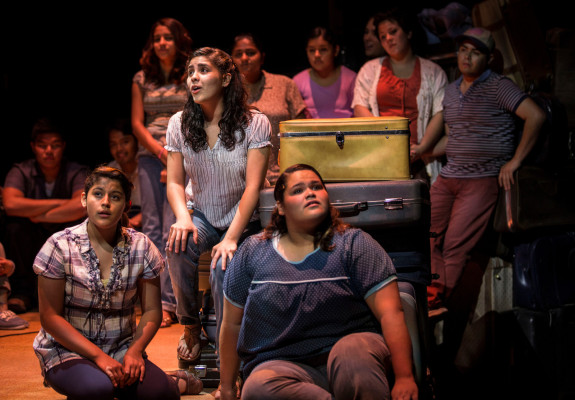
APTP performs Home/Land at the Goodman Theatre.
Home/Land, the play we created from this ethnographic journey, opened in January, 2012, thirteen months after the project began. The 90-minute play had a dozen main characters culled from our year of interviews and encounters. It was performed by mostly the same youth who had conducted the ethnography. A seventeen year-old, undocumented Filipino played an undocumented Mexican father separated from his family by detention then deportation. The daughter of an undocumented Mexican mother and Colombian father played an undocumented Palestinian who had lived in Kuwait and Jordan but never Palestine. A gay leader in the undocuqueer movement was played by a gay APTP ensemble member who would come to see his character as a role model. The son of Vietnamese refugees played an undocumented Honduran father nearly driven mad by the ankle monitor he wears for months while fighting against deportation. An activist nun was played by an undocumented eighteen year-old who, shortly after the play closed, would accept voluntary departure and leave the U.S. for Ecuador.

Stephanie Castrejon’s field notes inspired one of the production’s most haunting scenes, as two columns of youth actors shuffled across the stage in orange jump suits and shackles. As full of despair as that image was, it was paired with the image of activists standing in vigil, holding hands in solidarity, and the story of two nuns who had subversively used the right to clergy to serve as a liaison between detainees, their families, and legitimate legal counsel. That scene was followed immediately by a stylized rally that filled our theater every night with the stomping, clapping, and dancing of irrepressible resistance.
Home/Land ran for three months in our theater on the northwest side, then later transferred to the Goodman Theatre, reaching a total audience of more than 7,000 people. PBS NewsHour did a feature on the production that aired nationally. We made a DVD and commissioned a curriculum for middle- and high-school classes. Northwestern University Press anthologized the script, which was collaboratively devised by more than 35 youth and adult artists. Just last week, forty students at a predominantly immigrant high school in Santa Rosa, California performed the play, the first time one of APTP’s scripts has ever been produced by another group.
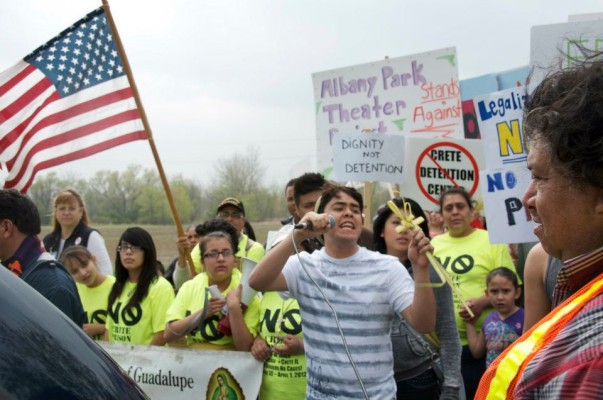
APTP rallys in the Village of Crete against a proposed immigrant detention center.
Every person we interviewed came to see the play. Teen cast members greeted as heroes the real-life counterparts of the characters they played, who in turn praised the teens as bold activist-storytellers. One night, when two of the Women Divorced by ICE were in attendance, they told our company members that they were planning to march from Little Village to the Village of Crete, south of Chicago’s city limits, to protest the planned construction of a new immigrant prison by one of the country’s most notorious private prison contractors. The APTP youth asked how they could participate, especially as our performance schedule would keep us in Albany Park for the first two days of the march. The women replied that they needed water, food, and maybe money to hire a bus to bring them back to Chicago after the 3-day walk. For the next two weekends, APTP teens took a collection after Home/Land, using their performances to raise $2,000 to support the march. Two teens took CTA from Albany Park to Little Village and presented the money to La Mision following Sunday morning mass. Inspired by the enthusiasm and investment of youth, signups for the march grew that day from 10 participants to more than 60. The first two days of the march, APTP was performing Home/Land in Albany Park; the third day, we joined the marchers in Crete, bringing a burst of youthful energy, a drum circle, and fresh chants as nearly a thousand people walked a parade route down Main Street to the site of the proposed prison. A couple months later, the board of the Village of Crete voted to decline the Department of Homeland Security’s proposal.
To conclude my description of our Home/Land project, I want to read to you from the college application essay written by Lilia Escobar, the daughter of Mexican and Colombian immigrants who was one of our lead ethnographers and who played the undocumented Palestinian activist:
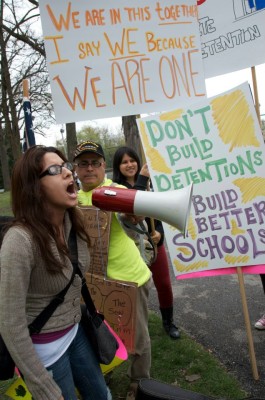
Lilia Escobar leads chants in the rally against an immigrant prison in Crete, Illinois.
“There’s a difference between the stories you hear on the news and the stories you can find in your own neighborhood. For me, the most meaningful character I portrayed [in Home/Land] was Ahlam, an activist, a student, and someone I grew to look up to. The first time I ever saw her, she was giving a speech at a rally. I looked at this Muslim woman, someone who I probably would have been afraid to talk to previously, and I could relate to her emotion. She expressed herself so clearly and honestly, and she had a rhythm to her words that spoke to my soul. The next time I saw her was in our APTP home as we interviewed her for our play. She told the tale of a young, fearless girl who once had a stable life in a home she loved. She told of a rough move to the United States and the trauma that created. She described in perfect detail the shell within which she enclosed herself, as fear overcame her. When she thought she lost all her possible opportunities in life, she discovered that her only way out was to face her reality head-on. She became an activist and publicly announced her undocumented status in front of crowds, because she decided that the only way to get back the quality of life she once lived was to challenge people to change the laws that hold her back.
The journey for me of taking Ahlam’s story from an interview to the stage was transformational. Something in her courage and activism showed me what I am capable of accomplishing. I needed the world to hear this woman. Standing on our stage at APTP, I spoke her words – ‘I am done holding myself back’ – time and time again, for three months of performances, before thousands of audience members. Her words became my words, her testimony became my testimony, her struggle became my struggle.”
Lilia goes on to write about starting an immigrant rights club at her high school and then about the march in Crete, concluding that, “Our triumphs have shown me just how far my voice can reach.”
* * *

Lilia Escobar and Stephanie Castrejon never met Dwight Conquergood. Home/Land – everything I’ve described to you – happened years after Dwight’s death, but it would not – could not – have happened without Dwight’s life. To paraphrase from E. Patrick Johnson’s welcome this morning, Dwight prepared Albany Park Theater Project to survive and to thrive.
First and foremost, we learned from Dwight. We learned that it was okay, even desirable, to make a mess. Those who knew Dwight’s interventions and engagements understand when I say that Dwight was not afraid to let ethnographic practice become gloriously messy. You can see this in the relationship he built with Albany Park Theater Project. For five years, as he was researching the culture of our creative community – its values and practices – he was also shaping our culture and practice. While he was still alive, I began to hear Dwight in my head throughout APTP’s ethnography, devising, and rehearsal process. He changed – he complicated and improved – the way I do my work. And, to paraphrase from Lisa Merrill’s talk about marginalia earlier today, Dwight is still speaking to me. In a very real way, I still make all my work with Dwight’s voice very much in mind.
Dwight’s presence at APTP for five years insured that critical thinking became one of the most cherished values and practices among APTP youth. Even as he observed them, they observed him. I remember Dwight coming to APTP, straight from Swedish Covenant Hospital, chemotherapy pump strapped to his waist, IV drips running into his veins – he confided to me that he was probably high on steroids and stoned on antiemetics – and for three spellbinding hours he gave a performance-presentation on his death penalty work that challenged, and fundamentally changed, our teens’ assumptions and attitudes and politics.
To understand Dwight’s influence on our APTP community, we need only look at the life journeys of the two generations of teens who overlapped with him at APTP:
• Marta Popadiak majored in sociology and now leads the Minneapolis office for Senator Al Franken’s reelection campaign. Asked what issues most motivate her, Marta answers: “I am most motivated by issues of economic justice. The ‘American dream’ narrative where folks work hard and pull themselves up by their bootstraps is crap….Eventually, I dream of coming home to Chicago. I am going to smash Chicago’s political machine and organize a peoples’ government by working to engage all people from all communities to hold Chicago’s elected official accountable to a more socially, racially, and economically just city.” (See related story)
• Miguel Rodriguez majored in sociology and dance and now teaches fifth grade in the Bronx, in one of the poorest congressional districts in the country. He says of his teaching, “I take on many roles with my students: teacher, mentor, dance instructor, and advocate. I push them to engage with rigorous texts, fall in love with literature, fall in love with themselves, fall in love with the community they come from.” (See related story.)
• Elizabeth Cobacho majored in sociology and political science and has since taught in Brazil, Tunisia, and Islamabad.
• DJ Narvaez teaches fifth grade at a predominantly immigrant school and serves on APTP’s board of directors.
• Maggie Popadiak majored in sociology, she now leads APTP with me, and we are now married.
Similarly to past APTP generations, many of the ensemble that created Home/Land are now in college and, as you hear what they are doing, keep in mind that none of them ever met Dwight in person. Lilia Escobar is a sociology major about to study abroad in Central America for the second time. Stephanie Castrejon is a double major in anthropology and theater and spent this year touring a performance about the disappeared women of Juarez, Mexico. Jancillin Chacko is trying to create a major that combines sociology, economics, math, and gender studies.
One can also witness Dwight’s influence in the gloriously messy relationships APTP builds with its research subjects. In the process I described to you, in Lilia’s recounting of meeting, interview, and “playing” Ahlam, who is the ethnographer, who is the subject, who is the activist, who is the advocate, who is the teacher, who is the student, who is the authority, where is the power?
And, in one of Dwight’s more profane but no less profound gifts to Albany Park Theater Project, he left APTP an extraordinary financial bequest, the result of the frugal life he led. That bequest kept APTP afloat through the Great Recession – we undertook the epic Home/Land project at a time when most non-profits were shedding staff and paring programs. Dwight’s bequest has also funded numerous small grants to APTP alumni: JP Marquez, an undocumented young man, is currently able to study anthropology and biology at Beloit College in part thanks to a grant from Dwight’s bequest.
* * *
Dwight never wrote the journal article he proposed on the day we met. Truth be told, I’m not certain he ever would have. In the case of Albany Park Theater Project, Dwight was too busy co-authoring our creative and critical community of artist-activist boundary busters.
Click here to purchase “Cultural Struggles,” an extraordinary collection of writings by Dwight Conquergood, with essays ranging from his ethnographic study of an apartment building in Albany Park to his bracing analysis of the death penalty as lethal theater.

Professor Dwight Conquergood
 Menu
Menu
